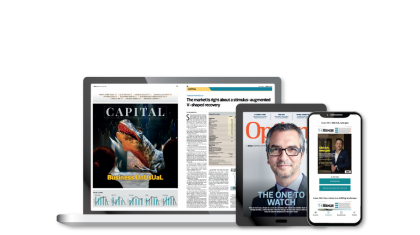
 Hill would learn that many of the works were studies for larger, immersive installations. “Study for Path”, for example, shows a procession of humans through a forest. It is a 70in version of a 70ft projection. One edition is held by the Guggenheim and another is owned by French billionaire Francois Pinault.
Cohan also revealed that Viola is having a yet-to-be-announced solo show at the Barnes Foundation in Philadelphia next year.
“Whenever you talk to anybody who knows the artist, you learn something,” Hill said as he walked to his next stop, the Luhring Augustine booth, where he found the beer can, pills and a work by Christopher Wool, an artist he collects in depth.
On it went, to be repeated in hundreds of interactions until the fair closed on March 4. Hedgefund manager Barry Rosenstein lingered in front of glittery Lynda Benglis sculptures, but that may have been because his wife was chatting up another guest about the play Miss You Like Hell. Blackstone’s A J Agarwal and Steve Scherr of Goldman Sachs could have easily brushed past Woody Allen or Steve Martin near a placard labelled “Visual Irony” at Thomas Colville.
Don Marron’s son William studied works on paper by Nicole Eisenman and declared his favourite: “Saturnista,” with an asking price of US$26,000. Anton Kern had already sold it to the Morgan Library and Museum. “He’s got a good eye,” said Marron, after making lunch plans with Kern.
Hill would learn that many of the works were studies for larger, immersive installations. “Study for Path”, for example, shows a procession of humans through a forest. It is a 70in version of a 70ft projection. One edition is held by the Guggenheim and another is owned by French billionaire Francois Pinault.
Cohan also revealed that Viola is having a yet-to-be-announced solo show at the Barnes Foundation in Philadelphia next year.
“Whenever you talk to anybody who knows the artist, you learn something,” Hill said as he walked to his next stop, the Luhring Augustine booth, where he found the beer can, pills and a work by Christopher Wool, an artist he collects in depth.
On it went, to be repeated in hundreds of interactions until the fair closed on March 4. Hedgefund manager Barry Rosenstein lingered in front of glittery Lynda Benglis sculptures, but that may have been because his wife was chatting up another guest about the play Miss You Like Hell. Blackstone’s A J Agarwal and Steve Scherr of Goldman Sachs could have easily brushed past Woody Allen or Steve Martin near a placard labelled “Visual Irony” at Thomas Colville.
Don Marron’s son William studied works on paper by Nicole Eisenman and declared his favourite: “Saturnista,” with an asking price of US$26,000. Anton Kern had already sold it to the Morgan Library and Museum. “He’s got a good eye,” said Marron, after making lunch plans with Kern.








